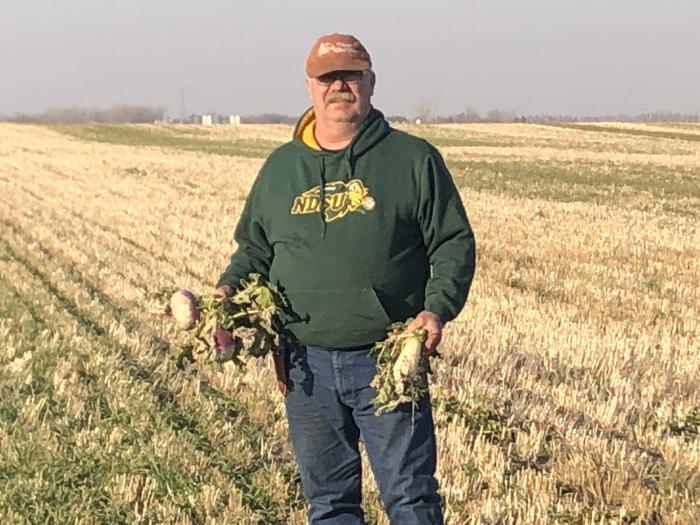Commitment To ‘Keep learning’ About Conservation Pays Off in Bottineau County
"I’m still learning, and I’m going to keep learning until I die,” says Pete Artz of the conservation efforts he’s employed on his Bottineau County cattle and crop operation.
Kindra Gordon writes from Whitewood, S.D.
The fifty-nine-year old, third generation farmer has added cross-fencing, water developments, rotational grazing, soil testing, cover crops, and cover crop grazing to his operation over the last fifteen years, and says, “It’s definitely been beneficial.”

Artz and his wife, who have six adult-age children, live in the town of Bottineau, N.D., but their farm is located at Antler, N.D., which is just four miles south of the Canadian border. It’s a forty-three-mile commute for Artz to the farm; his wife commutes to work thirty-two miles the other direction.
Artz, with the assistance of a young man in his mid-20s, runs 400 commercial mother cows along with 100 yearling stockers, usually replacement females. They also farm 3,500 acres, which is mostly dedicated to wheat, field peas, and crops that provide feedstuffs for the cow herd, such as a pea and barley mixture used for green chop. The addition of cover crops after the cash crops are harvested has helped boost organic matter, water holding capacity, and even bump up yields – while also providing additional grazing for the cowherd.
Of his interest in conservation, Artz says it started about 15 years ago when he attended a few conservation seminars and learned about conservation practices other producers were using. Thus, he started trying different things – beginning with a simple change of winter feeding his cows in different locations in the pasture to help spread the nutrients around.
Artz continued to learn and became friends with fellow North Dakota producer Gabe Brown and others. Through the Bottineau Natural Resources Conservation Service (NRCS) Field Office, Artz gained technical assistance from District Conservationist Amy Sand, and gained insight into rotational grazing systems and cover crop strategies.
Of Artz’s willingness to learn, Sand says, “He’s always going above and beyond, researching innovative ideas on his own. He’s motivated to do conservation practices that benefit soil health and the livestock, and he’s been willing to continue conservation practices even without cost-share funding.”
His conservation-minded changes included cross-fencing and moving his calving season from January and February to April, noting that it seemed to fit the resources better and was easier on the cattle. He secured a contract for the Conservation Stewardship Program (CSP) and began to experiment with cover crops.
He shifted away from raising corn for silage to using a pea-barley mix to green chop, and explains, “With corn harvest it was too late to get a cover crop in. I didn’t like leaving the ground bare all winter. I don’t think that’s good for soil health. With the pea-barley mix, I get a cover crop on as fast as I can after we green chop.”
Over the years, he’s come to like a cover crop mix that includes radish, turnip and oats, and then he’ll fill out the mix with whatever other seed he has – possibly millet or canola. He says, “Use what you’ve got to save some costs.”
While Artz appreciates what the cover crops do for soil health, he’s found the real benefit comes from having the cattle graze that land and add urine and manure nutrients to the soil system.
He believes in cover crops so much, he’s continued to plant them even without government cost-share assistance.
As a result of his investments in conservation, Artz says, “I know I wouldn’t be as well off.” That said, he’s continuing to strive to learn and improve. Artz intends to experiment with more intense livestock grazing, using higher stock density for shorter periods. “Right now, we move the cattle every couple weeks. I want to try hitting a pasture hard one time, leaving more grass to shade the ground, and letting it rest,” he shares.
Artz is also hopeful that cover crop technology will improve. Because of their northern location and shorter growing season, he’s found that seeding after harvest can often be too late. He would like cover crop seed to be developed with a time release coating. “I’d like to seed that with my spring crops, but the time release coating wouldn’t let the cover crop start growing until July. I’d love to be the guinea pig and try something like that,” he says.
Looking ahead, Artz calls conservation a “win for the farm, the land and the next generation.” With the high cost of land today, he adds, “The only way the next generation is going to make it is with conservation to add efficiency.”

